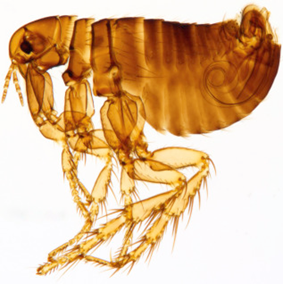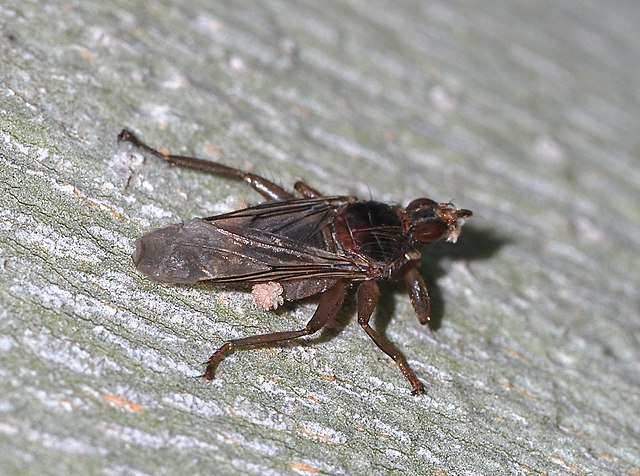PARASITOLOGY LABORATORY MIDTERMS
1/132
There's no tags or description
Looks like no tags are added yet.
Name | Mastery | Learn | Test | Matching | Spaced |
|---|
No study sessions yet.
133 Terms
Holoptic Eyes
Eyes that are closer together, almost touching at the top of their heads
Asclepius
Greek God of medicine and healing; son of Apollo
Dichoptic Eye
Eye arrangement where the eyes do not meet in the middle of the head
Pterygota
With wings
Apterygota
Without wings

Human Flea
Pulex irritans

Louse fly
Pseudolynchia canariensis
Halteres / Balancers
The small wings which is a highly sophisticated balance organs and they oscillate during flight
Spiracles
Breathing organ for most insects
Hermes/Mercury
herald of the Gods and protector of travelers and merchant
Rod of Asclepius
Symbol of medicine
Staff of Caduceus
Symbol of commerce
Ectoparasite or External Parasite
Parasites occurring on the surface of the body (Infestation)
Endoparasites or Internal Parasites
Parasites occurring inside of the body of the host (Infection)
Pseudoparasites
Objects which are often mistaken for true parasite eggs and larvae because it resembles them
Facultative Parasites
Parasites that could exist both as free-living or parasitic Fixed parasite – parasites that cannot pass spontaneously from one host to the other e.g. helminths
Erratic Parasite
Those that occur in organs away from their normal location Monoxenous parasite - those that require only one host to complete their life cycl
Heteroxeneous Parasite
Those that require 2 or more hosts to complete their life cycle
Zooparasite
Parasite that is highly specific for animals e.g. Oxyuris equi
Anthropoparasite
Highly specific parasite for man e.g. E. vermicularis
Anthropozooparasite
Equally specific for man and animals e.g. T. spiralis
Definitive or Final Host
Animal in which the adult, reproducing stage of the parasite occurs
Primary or Prime Host
The animal in which the parasite is commonly found
Secondary or Intermediate Host
The animal in which the immature stage of the parasite occurs
Reservoir Host
The animal which harbors the parasite but does not manifest clinical signs and may serve as reservoir for parasite infection of other animals
Paratenic Host
The animal which needs to be eaten by the definitive host in order to pass down the development stage of the parasite
Aberrant host or Accidental Host
Animals which do not normally serves as the parasite host
Transport Host
Animal which serves as the intermediary link the parasite development
Dioecious
Male and Female sex organs are in separate individual
Monoecious (Hermaphrodite
Male and Female sex organs are in the same individual
Prepatent Period
The period from the time of infection up to the time the adult or eggs are demonstrated or observed
Patent Period
The period from the time adult or eggs are demonstrated or observed up to the time that they are no longer present in the host
Bionomics
The study of external requirement such at temperature, humidity, nutrition, and pH for the survival of the organism
Biotic Potential
Capacity of the organism for biological success and is usually associated with reproduction
Indirect life cycle
Presence of intermediate host
Direct life cycle
Without intermediate host
Hypobiosis
Quiescence stage or dormancy
Mechanical / Non-cyclical Transmission –
When no change in form or development occur in the arthropod body e.g T. evansi; amoeba; helminth ova
Biological transmission / Cyclical Transmission
There is change in form or development of the parasite or organism in the body of the arthropod
Cyclopropagative Transmission
The organism undergoes cyclical changes or change in form as well as in number (multiplication) in the body of the arthropod e.g Plasmodia in mosquito
Cyclodevelopmental Transmission
The organism undergoes cyclic development changing in form and size but no change in number, no multiplication in the body of the arthropod e.g. Dirofilaria immitis in the mosquito
Propagative Transmission
The organism undergoes multiplication in the arthropod but there is no cyclical development or change in form and size e.g. Pasteurella pestis in the gut of the rat flea (Bubonic plague)
Transovarian Transmission or Hereditary Transmission
Transmission of infection is through the next generation of ticks. After the mature female tick ingests the parasite, the parasite invades the developing tick egg and when the young tick emerges, it carries with it the infective organism, then the mother dies after laying eggs e.g. Babesia in tick
Transtadial
Organism is transmitted by the next developmental stage of ticks e.g. Theileria in tick
Phoresy
Transport of small parasite by bigger parasite. Eggs of some flies are attached to abdomen of another fly and hatched then deposited or transferred in another host e.g. Dermatobia hominis egg in the abdomen of mosquito
Foveal Gland
Specialized glands found in certain arthropods such as mites & ticks; secretes substances such as pheromones to attract mates in ticks
Gene Pore
Organ which stores the sperm cell in females; allows a single act of mating to render the female fertile for life
Holometabolous
Immature stages of life cycle are entirely different from the adult
Hemimetabolous
Immature stages are similar to the appearance of adults
Hymenoptera
Stinging insects (E.g. Bees and Wasp)
Coleoptera
Includes beetles and weevils
Elytra
Hardened wings
Hemiptera
True flies (Stink bugs)
Odonata
Order of predatory flying insects that includes dragonfly or damselfly
Pterostigma
A group of specialized cells in the outer wings of insects, which are often thickened or colored.
Tegmina
A thickened forewing of some insects, it is also seen on the wings of the cockroaches
Ecdysis
Molting; The process of casting off the outer cuticle
Instar
The period between 2 stadia
Stadium\Stadia
The time interval between molts
Buboes
Swollen lymph nodes which is one of the recognizable symptoms of bubonic plague
Anautogenous
Female insects require a specific type of meal to mature their egs (e.g. mosquito and blood)
Cimex
Another term for bedbugs
Adeagus
Another term for penis
Genital Orifice
Exterior opening of the genital
Microtrichiae
Are fine cuticular foldings gives iridescent color pattern to insects which is important in sexual recognition and camouflage
Yellow, Orange and Red
Due to the deposition of carotenoid pigments
Brown
Due to melanin pigment
Green and Purple
From microtrichiae which selectively scatter or reflect light of specific wavelength
Antenna
Commonly known as feeler
Stemmata
In larvae of holometabolous, it is a single-lensed positioned bilaterally on the larval head.
Ocelli
In larvae and adult of hemimetabolous
Retinular Cells
Contains black or brown photosensitive protein molecules (Rhodopsin)
Pulvilli
2 pad-like structures between the claws
Empodium
Central bristle or pad surrounding the pulvilli
Membranous
Wings that can be seen in the dragonfly
Scaly
Wings that can be seen in butterfly
Vein
Rod-like structure found in the wings
Comstock-Needham System
Naming system of insects using veins
Discal Cells
Is a cell within the wing of some insects. It is known as “Hatchet Cell” in Tsetse Fly
Ovipositor
A tubular structure that is used for laying eggs.
Cerci
A sensory organs at the terminal portion of the abdomen which also serve as pinching weapon or as organ of copulation
Supraesophageal Center
The nervous system of insects is composed of the dorsal brain in the head.
Ganglionated Ventral Nerve Cord
Series of ventral cord/ganglia
Foregut or Stomodeum
Mouth, pharynx, esophagus, crop and gizzard/ proventriculus; armed with teeth for crushing and grinding of food
Hindgut or Proctodeum
Colon, rectum, anus, malphigian tubules; absorption of water
Midgut or Mesenteron
Mid intestine connects the stomodeum to the proctodeum; principal site of digestion and absorption; secrete digestive enzymes
Circulatory System
Large dorsal tube (heart) and valves; blood consists of watery fluid (serum or plasma) and white corpuscles which are colorless or greenish yellow
Lung Book
Found in spiders and scorpions
Gill Book
Found in crabs and other crustaceans
Peritreme
A rounded plate that surrounds the spiracle of some insects
Tracheoles
Primary site of gas exchange
Spermatosphere
Packets of sperm which protects it during insemination
Male Reproductive System
Testes
Vas Deferens
Accessory Organ
Seminal Vesicle
Ejaculatory Duct
Penis or Adeagus
Female Reproductive System
Ovaries
Oviduct
Vagina
Ovipositor
Spermatheca
Paired Nephridia
Excretory System of Crustaceans
Malphigian Tubules
Excretory System of Insects and Mites
Coxal Gland
Excretory System of Arachnids
Oviparous
Lay undeveloped eggs e.g Housefly and Stable Fly
Ovoviviparous
Lays larvated eggs
Viviparous/ Larviparous
Lays fully-developed larva e.g. Flesh Flies, Tsetse Fly, Oestrus ovis